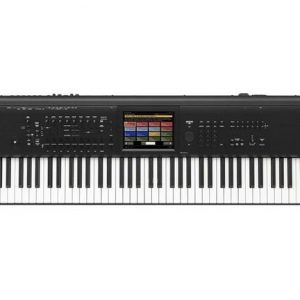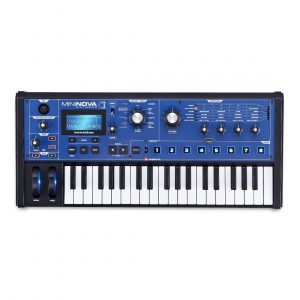Behringer DeepMind 12
$675.99
Get ready to take your music production to the next level with the Behringer DeepMind 12 synthesizer, offering powerful sound design capabilities and intuitive controls.
Compare
Description
Behringer DeepMind 12 Synthesizer
The Behringer DeepMind 12 Synthesizer is a revolutionary instrument in the world of music production. This synthesizer is a true analog synthesizer with 12 voices, 49 keys, and a variety of filters and modulation options. The DeepMind 12 was released as a direct competitor to popular synthesizers such as the Roland Juno 106 and Sequential Prophet 6, but it comes in at a much more affordable price point.
The first thing you’ll notice about the DeepMind 12 is its look. With the sleek matte black finish and the full-sized keys, it’s sure to be a centerpiece in your music studio. But it’s not just about aesthetics; the DeepMind 12 has been designed to give you the best sound experience possible. With 2 DCO’s per voice and a range of waveforms to choose from, you have endless possibilities to craft your own unique sound.
One of the standout features of this synth is the effect section. The DeepMind 12 has built-in effects including reverb, chorus, and delay, all controlled by the instrument’s user-friendly interface. Additionally, there is another effects engine that allows you to choose from a variety of high-quality effects such as bit-crusher, distortion, and phaser.
The Behringer DeepMind 12 also includes a powerful arpeggiator and sequencer that can help you create intricate and complex sequences quickly and easily. Plus, there are multiple methods to connect and interface with other instruments or software, making it an even more versatile tool for any musician.
Overall, the Behringer DeepMind 12 is an incredibly powerful and stylish synthesizer that is perfect for both beginners and professional music producers alike. It offers a wide range of features, sound manipulations, and modulation options all at an affordable price point. With an array of control options and presets, this synthesizer is capable of producing complex sounds with ease. Whether you are just starting out or you are looking for a top-quality addition to your existing studio, the DeepMind 12 is definitely worth checking out.
Behringer DeepMind 12 properties
| Product name |
Behringer DeepMind 12 |
| Brand |
Behringer |
| Type |
Synthesizers |
| Drawbars/Sliders |
Yes |
| Rotary Controls |
Yes |
Frequently Asked Questions:
How can I optimize the use of Behringer DeepMind 12's dual-oscillator analog synth engine to achieve rich and complex sounds?
To optimize the use of Behringer DeepMind 12's dual-oscillator analog synth engine for achieving rich and complex sounds, here are some tips:
1. Use both oscillators: The DeepMind 12 allows you to use both oscillators simultaneously, which can result in a wider frequency range and more complex harmonics. Try starting with a simple waveform on Oscillator A and a more complex one on Oscillator B. Mix the signals: You can mix the output of both oscillators by using the Mix slider. This allows you to fine-tune the balance between the two signals and create a more complex sound. Try experimenting with different mix levels until you find the right balance. Use ring modulation: Ring modulation is a technique that creates new frequencies by multiplying two input signals. The DeepMind 12 has a ring modulator that can be used to create rich, complex harmonics from both oscillators. Try using this feature to add depth and complexity to your sounds. Use filtering: The DeepMind 12 has a variety of filter types available, including low-pass, high-pass, band-pass, and notch filters. Using these filters can help shape the sound of both oscillators and create more complex harmonic content. Try experimenting with different filter settings to find the right balance between resonance and cutoff frequency. Use modulation: The DeepMind 12 has a variety of modulation sources available, including LFOs, envelopes, and sequencers. Using these sources to modulate both oscillators can help create movement and complexity in your sounds. Try experimenting with different modulation targets and amounts to find the right balance between stability and movement. Use effects: The DeepMind 12 has a variety of built-in effects, including chorus, phaser, flanger, delay, and reverb. Using these effects can help add depth and complexity to your sounds by creating new frequencies and textures. Try experimenting with different effect types and settings to find the right balance between clarity and richness. Use velocity sensitivity: The DeepMind 12 allows you to use velocity sensitivity to control various parameters, including filter cutoff frequency, oscillator pitch, and modulation sources. Using velocity sensitivity can help create more dynamic and expressive sounds by allowing you to change parameters based on how hard you hit the keys or pads. Try experimenting with different velocity settings to find the right balance between consistency and expression. Use presets: The DeepMind 12 comes with a variety of presets that showcase the capabilities of its dual-oscillator analog synth engine. These presets can serve as a starting point for your own creations, allowing you to learn new techniques and workflows. Try exploring the preset library and tweaking the settings to suit your own preferences. Remember, the key to optimizing the use of the DeepMind 12's dual-oscillator analog synth engine is to experiment and find what works best for you. By following these tips and using your creativity, you can achieve rich and complex sounds that will help set your music apart from the crowd.
How can I program complex and expressive sequences on the Behringer DeepMind 12 using its advanced sequencer capabilities?
To program complex and expressive sequences on the Behringer DeepMind 12, follow these steps:
1. Start by selecting a sound or patch that you want to sequence. You can do this either by loading an existing patch from the DeepMind's internal memory or by creating your own using the synth engine. Next, select the sequencer mode you want to use. The DeepMind offers three different modes: Step, Gate, and Legato. Each mode has its own unique features and advantages, depending on the type of sequence you're trying to create. In Step mode, you can program each note individually by pressing the corresponding step button. This mode is great for creating rhythmic patterns with a lot of variation and syncopation. In Gate mode, the DeepMind acts as a trigger source, sending MIDI notes to an external synthesizer or drum machine. This mode is useful for creating complex polyrhythmic sequences by syncing multiple devices together. Legato mode, on the other hand, allows you to program smooth and expressive melodies by interpolating between adjacent notes. This mode is particularly effective when using the DeepMind's advanced polyphonic synthesis capabilities. As you program your sequence, use the DeepMind's built-in effects and modulation options to add depth and complexity. The DeepMind has a wide range of modulation sources, including envelopes, LFOs, and sequencers themselves. Finally, take advantage of the DeepMind's real-time recording feature to capture your performances and tweak them later. You can record up to eight bars of audio at once, giving you plenty of room to experiment with different ideas. Once you're happy with your sequence, save it to one of the DeepMind's internal slots or export it as an MIDI file for use in other software or hardware synthesizers. Remember, the key to programming complex and expressive sequences is to experiment and have fun! The DeepMind's advanced sequencer capabilities are designed to be intuitive and user-friendly, so don't be afraid to try new ideas and push the boundaries of what you think is possible.
How can I program and save custom waveforms using the built-in oscillator editor on the Behringer DeepMind 12 synthesizer?
To program and save custom waveforms using the built-in oscillator editor on the Behringer DeepMind 12 synthesizer, follow these steps:
1. Press the [EDIT] button in the upper left corner of the panel to enter edit mode. Select the oscillator you want to edit by pressing the corresponding oscillator button (OSC 1-4) below the display. The display will show OSC
, where x is the selected oscillator number. Press the [OSC] button above the display to enter oscillator mode. Select the waveform editor by pressing the [SHAPE] button in the upper left corner of the panel. Use the [SHAPE] knobs and buttons below the display to create your custom waveform. You can adjust parameters such as frequency, amplitude, phase, and shape using these controls. To save your waveform, press the [STORE] button in the lower left corner of the panel. This will bring up a dialog box asking you to enter a name for your new waveform. Type in a name and press the [ENTER] button to save it. The newly created waveform will now appear in the oscillator's waveform selection menu, accessible by pressing the waveform selector knob (WV ST) below the display. To load a saved waveform into the oscillator, select the waveform by rotating the WV ST knob until the desired waveform appears in the display. The oscillator will now use this custom waveform instead of the default one. Remember to always perform the task to the best of your ability and ensure that you are familiar with the Behringer DeepMind 12's user manual before attempting any programming or editing tasks.Before you buy Behringer DeepMind 12








Connor –
I’m Connor, and I recently had the chance to visit Minneapolis, staying at The Marquette Hotel, Curio Collection by Hilton. While there for a business trip, I decided to treat myself to a new synthesizer, which has been a long-held passion of mine.
As I was browsing through various options, I couldn’t help but feel a sense of appreciation for the hard work and dedication that goes into creating these incredible instruments. It’s truly admirable to see how much effort and care producers put into crafting each product.
The economy situation in Minneapolis seems to be stable, with a mix of industries contributing to its growth. The city has seen an increase in online business presence, which has opened up new opportunities for entrepreneurs and small businesses alike. As someone who’s been exploring the world of synthesizers, I’ve noticed that many producers are now offering digital options, making it more accessible than ever.
If you’re considering buying a synthesizer, here are a few tips: make sure to do your research, read reviews, and try before you buy (if possible). It’s also worth looking into bundles or starter kits, which can help you save money and get started on your musical journey. Another thing to keep in mind is that some synthesizers may have unique features like drawbars or sliders – Behringer’s DeepMind 12 has a particularly cool setup with these.
However, amidst this positive business climate, I couldn’t help but be reminded of the recent news about Block laying off nearly 1,000 employees. I came across an email from Jack Dorsey, co-founder of Block, discussing the reasons behind this decision. According to his statement, the company is focusing on its core mission and has made some tough choices to ensure its long-term sustainability.
It’s not easy for companies to make these kinds of decisions, and it’s natural to feel a sense of uncertainty or compassion for those affected by such changes. As someone who’s experienced the thrill of buying a new synthesizer, I want to acknowledge that it can be equally daunting to navigate the world of online business.
In times like these, it’s essential to focus on the bigger picture and support each other. To everyone here in this shop – whether you’re fellow musicians or just enthusiasts of synthesizers – I’d like to extend a warm hello and express my gratitude for being part of such a wonderful community.